7+ SAMPLE Scope Management Plan
-
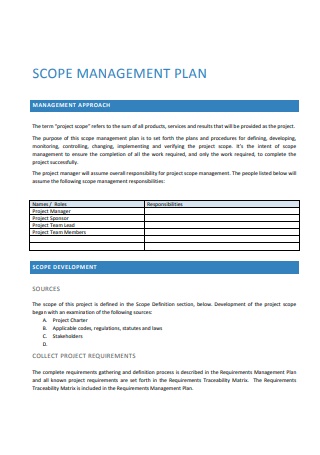
Scope Management Plan Template
download now -
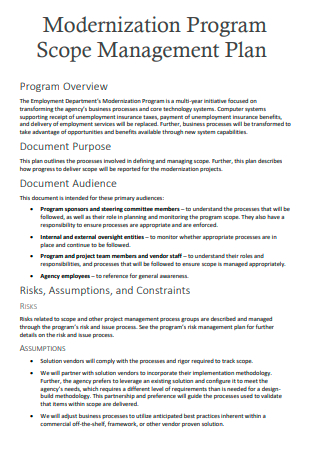
Modernization Program Scope Management Plan
download now -
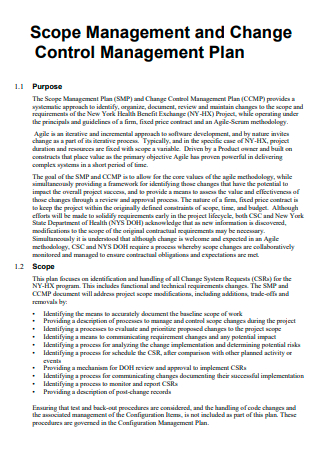
Scope Management and Change Control Management Plan
download now -
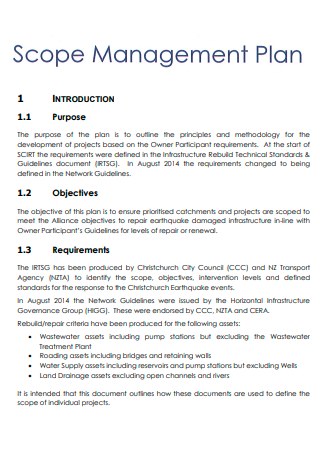
Basic Scope Management Plan
download now -
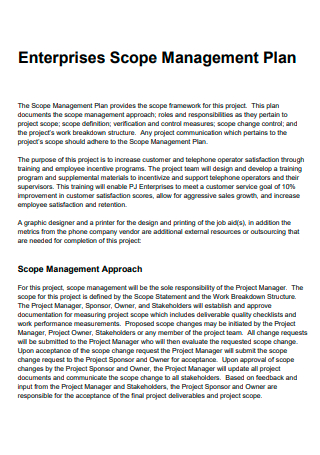
Enterprises Scope Management Plan
download now -
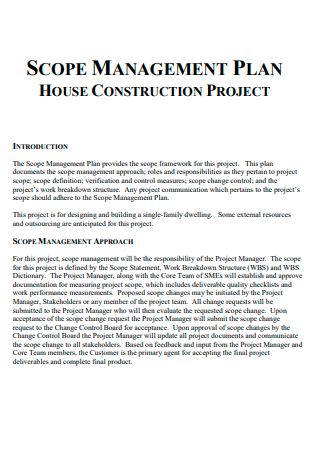
House Construction Project Scope Management Plan
download now -
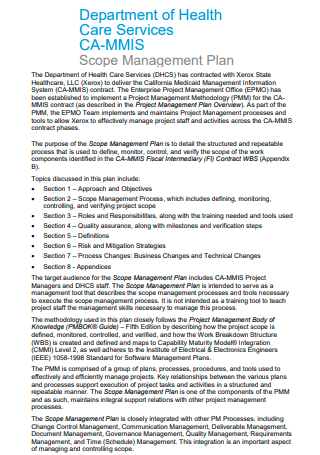
Department of Health Scope Management Plan
download now -
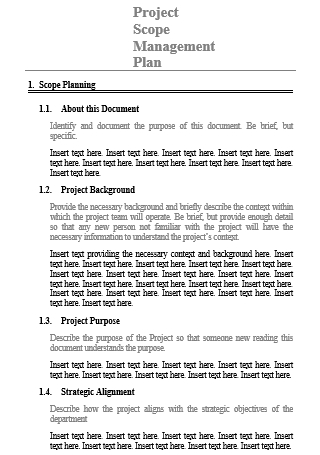
Project Scope Management Plan
download now
FREE Scope Management Plan s to Download
7+ SAMPLE Scope Management Plan
What Is a Scope Management Plan?
Components of a Scope Management Plan
How To Write a Scope Management Plan
FAQs
What are the principal inputs of a scope management plan?
What is scope planning?
What is the purpose of having a scope management plan?
What Is a Scope Management Plan?
A scope management plan consists of processes and procedures that are in place to guarantee that a project consists of all the necessary tasks for its completion. The primary concern of a scope management plan is to guarantee that the defined scope of the project stems from explained, structured, developed, and verified procedures. Through a scope management plan, project managers and supervisors can specify and construct their project for it to remain within the specified scope. It also helps protect the project managers to carefully and correctly allocate their resources to guarantee that the project finishes on time, within the budget plan, and with the quality that the stakeholders and clients expect. There are instances in which the project management plan includes the scope management plan. As such, it must include the processes that they need to follow to complete the project and how the project team monitors and controls these processes. Understanding the scope management process sets up the project management team for success. The purpose of a scope management plan is to create a project structure by documenting the necessary resources to achieve the project objectives. Scope management plans also reduce the chances of scope creep and avoid common issues, including constantly altering conditions, overspending, wasted resources, and failure to fulfill deadlines.
According to the Project Management Institute and their Pulse of Profession 2020 report, only 46 percent of organizations make project management an integral part of their culture. Despite the statistical data that proves that companies implementing management are more likely to deliver on time and within budget.
Components of a Scope Management Plan
The number one reason that projects fall through is because of scope issues. The scope management plan, as a part of the project management plan, describes the processes of defining, developing, monitoring, controlling, and validating the scope of a project. The primary element of the scope management plan is the project scope statement. Aside from the scope statement, there are other parts of the scope management plan that must be present to create a comprehensive and functioning document. The section below covers the various components of a scope management plan to manage and control the project scope.
How To Write a Scope Management Plan
The Project Management Institute (PMI) develops the Project Management Body of Knowledge or PMBOK to help project managers and team members to understand and manage projects better. Through the PMBOK, different organizations, industries, and individuals can create and write a comprehensive scope management plan. There are six steps to help you develop a good and solid scope management plan that keeps the project on track.
-
1. Create the Scope Plan
The first step in the planning process for projects is to create a scope plan document. The document must include necessary information like the scope statement, a breakdown of project requirements, and the expected deliverables of the project. Aside from these elements, the plan must also incorporate a change control process, which is the process of change requests that can prevent any instances of scope creep. This is the document that the project team refers to in the later portions of the project. Individuals, teams, and organizations require the document for complex projects, especially if stakeholders are requiring them to produce many deliverables or there are a lot of changes in delivering outputs for the project. When creating the plan, make sure that it incorporates expert judgments from cross-functional and executive stakeholders. It is also necessary to hold scope kickoff meetings to guarantee that other managers and team members of the project can contribute to constructing the project scope statement.
-
2. Organize the Necessary Project Requirements
In this step of creating the scope management plan, the project team identifies the needs of the stakeholders and clients to meet the project objectives. The primary goal of this step is to gather a comprehensive list of all the requirements from stakeholders to prevent making drastic scope changes along the way. When collecting the project requirements, make sure that there is also a project charter or an elevator pitch that enables stakeholders to understand the project and ensure that it meets their expectations and requirements. The project team can also organize focus groups and workshops and develop prototypes of the deliverables.
-
3. Define the Scope of the Project
After collecting all the requirements from the stakeholders, make sure to turn the information into a well-defined and easily understandable scope with detailed product descriptions. The document must clarify the expectations and deliverables of the project for every team member to know what they need to accomplish. When defining the scope of the project, make a product analysis to determine from a different perspective if the output is up to the expectations and standards of stakeholders. The team can also generate different alternatives if risks arise.
-
4. Generate the Work Breakdown Structure
The WBS is a procedure that allows the team to break down the project into smaller sets of tasks. It enables all individuals working on the project to have a clear visualization of each component and assess and address the needs. The work breakdown structure creates a hierarchy of tasks that enables members of the team to monitor, control, and schedule the project. When writing the WBS, make sure to decompose the project objective into smaller categories. Another thing to consider is to automate the workflows to streamline the action plans and activities and enhance project visibility and transparency.
-
5. Validate the Project Scope
In this step, shareholders must sign off the scope management plan. This step ensures that the stakeholders have a comprehensive understanding of the deliverables to avoid the chance of scope creep. When validating the scope, make sure to inspect the pan thoroughly. Team members can assist one another in the final inspection of the plan.
-
6. Control the Scope of the Project
The last step in creating the scope management plan is to implement scope control. As the project progresses, make sure to monitor the project status and manage the necessary changes to the scope. To streamline scope control, utilize project management software. The resource allows the team to collect informative feedback and share files and status updates in real-time.
FAQs
What are the principal inputs of a scope management plan?
The different inputs of the scope management plan include a project charter, enterprise environmental factors, and the organizational process of assets.
What is scope planning?
Scope planning is the process of identifying the goals, objectives, tasks, activities, resources, budget, requirements, and timeline of the project.
What is the purpose of having a scope management plan?
The principal purpose of creating a scope management plan for an organization or a project team is to create an effective and comprehensive project structure through proper documentation of required resources to accomplish the project according to the standards and expectations of stakeholders.
Construct a scope management plan to keep track of all the requirements of stakeholders when it comes to a project. The plan also enables individuals, teams, and organizations working on a project to have a clear understanding of the project scope and specifies the tasks, activities, and actions that each individual must accomplish to complete the project. Constructing the scope management plan also prevents or lessens the chances of scope creep that results in wasting time and resources throughout the project implementation. Compose a scope management plan by downloading one of the available templates from the 7+ SAMPLE Scope Management Plan in PDF | MS Word in the article above.
